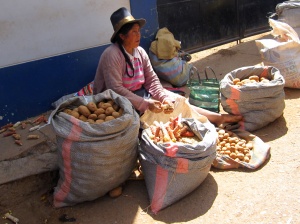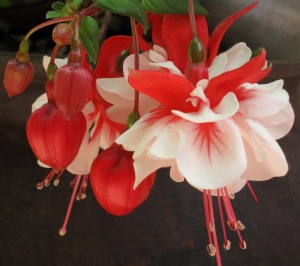
Generally women are the vendors of the fruits of labor in the Andean fields. They come from throughout the valley, arranging space on shared trucks or on three-wheeled cargo vehicles hoping to earn a handful of soles to bring home things they can't grow, like parts for the pump, school supplies for the children, or for transportation, which is often a luxury. Peru's poverty rate has declined in recent years, but still nearly 35% of Peruvians live below the internationally accepted poverty line of earnings less than $2 US per day. The vast majority of those live in the Andean highlands - that is, in my back yard.
Copyright Penelope Poole – 2011
My vision is to create an international demand for Edible Flowers from the Sacred Valley of the Incas by marketing certified organic, Sacred Valley-grown edible blooms, initially to the high-end hotels and restaurants between Cuzco and Machu Picchu that serve the growing multitudes of tourists to this ancient land. By organizing and certifying growers –especially women– to produce organic edible flowers, and by promoting activities and products to increase demand for edible flowers from the Andes — many of which are known aphrodisiacs — this project has tremendous potential to transform the economic conditions among the Quechua people, remove them from a reliance on coca production, while allowing them to maintain their traditions.
Major cultural differences are a large part of the visitor appeal to the Sacred Valley, en el camino to Machu Picchu, Wonder of the World and recently announced as the Ultimate Place to See Before You Die, but they remain in conflict with the pace of the planet. A land-owning Quechua family may have electricity, vehicles, and cellphones, but their house has earthen floors, no running water or heating system, and they measure their wealth by land area and animals. Yet their children are straddling the traditional and modern worlds. Many with a foothold between them will no doubt gain, but widows and single mothers – as everywhere in the world – are often left behind. This project offers a fresh opportunity to women who cannot work outside their homes.
My hope is that this project will snowball a trend all over the developing world. But here in the Valley we have the benefit of history and a ready-made brand.
My goal is to assist the Quechua people of the Sacred Valley in their participation in the imminent economic boom to their ancestors’ homeland and to give an opportunity to women-headed households to increase their incomes by doing something they already do for leisure – grow flowers. One can but imagine what the success of this initiative could do physically for the Sacred Valley and everyone who lives there, or has the pleasure of visiting. Help welcome, especially in the form of ideas, technical knowledge, or introductions.
(December 28, 2011)
6 Comments
Wow that sounds a really amazing project – I will follow it with interest! The flowers you can grow are so much more exotic that we can here in wet and windy North Wales but the best of luck to you it sounds if you are on to a winner!
Thanks for the encouragement Sarah. If it gets off the ground, I expect it to snowball… the beginning is the hard part!
Interestingly the flowers are very similar to what we grow here in Bancroft! I have many of the same varieties in my own garden and find it fascinating that the climate zone must be to some degree similar though am sure the growing season and mean temperature is much longer/higher than here. I have several ideas brewing for links to potential volunteer groups/funding, as well was distribution considerations. Very much looking forward to speaking! H:)
It’s called “the Columbian Exchange” http://en.wikipedia.org/wiki/Columbian_Exchange
Interestingly, nasturtium (the flowers of which are a favorite colorful and peppery addition to salads), which originate in Peru, grow now throughout the world in some 80 varieties, yet I cannot buy seedlings here, as they are considered wildflowers. Those in my garden were grown from cuttings in the field.
How is the project going? You have such amazing photos – with Spring here it must be stunning right now.
Everything happens slowly in the Valley and with the tourist season just beginning again next week now the rains have more or less stopped, the end user demand has been low, but there is definite interest. Actually, south of the equator here, we are now in autumn and indeed everything is blooming beautifully, including the heavenly jasmine… and as long as there is available water (not a problem in my little chakra), the growing season is year round. Chilly nights in mid-winter (July) but no frost here in the Valle Sagrado. Time to plant the broccoli, cauliflower, basil, and dill. 🙂